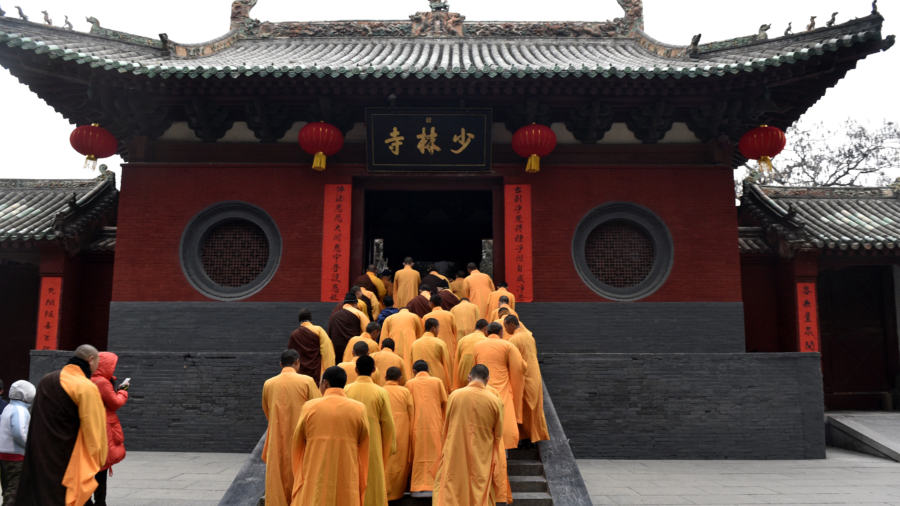The kung-fu-fighting monks of Shaolin Temple are world-famous ascetics, depicted in countless movies and television shows.
But under the Chinese Communist Party’s rule, the historic temple has become a shell of its former self. It is no longer a place for spiritual meditation but a business empire, with multiple companies established: a film and television company, painting academy, publishing house, and performing troupe among them.
Shaolin rents out its grounds as a venue for holding events, including a “bikini fashion” beauty pageant in the summer of 2009. That year, the temple also attempted to get listed on the stock exchange. If there was ever something to epitomize the idea of “selling out,” this would be it.
This blatant commercialization of religion has been endorsed by the Chinese regime for decades. In the era of the Cultural Revolution, Chinese Communist Party leader Mao Zedong denounced “old ideas, culture, customs, and habits,” commanding the destruction of countless historic sites, temples, monasteries, and places of cultural significance across the country. But with the opening up of the Chinese economy, local authorities have cashed in on the lucrative potential of people’s growing interest in Buddhist temples and Daoist monasteries. To boost local economies, destroyed structures were reconstructed and developed into tourist sites.
But they’re no longer places of worship. Like with many phenomena in an increasingly materialistic Chinese society, the sole motivation has become making money, from building scenic parks to attract tourists, to selling god statues for people seeking to secure blessings.
Recently, the Chinese Communist Party (CCP) has even recognized this flagrant commercialization is bad optics, and have called on religious organizations to tamp it down. On Nov. 23, 12 departments within the Party’s central authorities—including the Propaganda Department, United Front, Cyberspace Administration, and National Tourism Administration—published rules forbidding Buddhist and Daoist organizations to be operated as corporations. It prohibited business capital, personal investments, or contracts, as well as the sale of expensive tickets for admission into temple grounds, or services such as selling the first stick of incense to be placed in the censer, believed to bring good luck.
Monks Colluding with the Party
Decades of the warping of religion has already left its mark. The Party allowed the existence of Buddhist and Daoist organizations in order to keep up the facade of religious freedom, when in reality, it has appointed abbots as puppets of the Party.
Shi Yongxin, abbot of Shaolin Temple, is the most well-known example. He held several administrative posts, including deputy president of the Buddhist Association of China, the CCP-led body that supervises Buddhism activities, and president of the Henan Province division of the association. Shaolin is located in Dengfeng County, Henan Province. Former CCP leader Jiang Zemin also appointed him as a representative to the Party’s rubber-stamp legislature, the National People’s Congress.

According to an expose published in the Chinese business publication Caixin in August 2015, Shi had a close relationship with Jiang, the Henan party boss Li Changchun, and the Buddhist Association president Zhao Puchu. It was under Zhao’s instructions that Shi turned Shaolin Temple into a business empire, the report said.
Since the CCP took over Tibet, the Tibetan Buddhist lamas all need to be recognized and approved by the central authorities. To get approval, some Tibetan monasteries have resorted to bribing and currying favor with CCP officials. Chief among them is Zhu Weiqun, who was the deputy head of the United Front Work Department and tasked with handling Tibet affairs.
Tourism Above All
Meanwhile, notable temples have been forcibly seized by local officials to be aggressively developed and promoted as sightseeing destinations. The four sacred mountains of Buddhism, Mt. Wutai, Emei, Jiuhua, and Putuo, have all been developed into tourist-friendly attractions by local authorities or state-owned firms.
Xingjiao Temple in Xi’an City, Shaanxi Province is known for housing the remains of the Tang Dynasty monk Xuanzang, whose journey to India to seek Buddhist scriptures inspired the famous novel “Journey to the West.” When local authorities sought for the temple to be recognized as a UNESCO heritage site, they proposed for large parts of the complex to be demolished and replaced with a newer building, according to a report by the South China Morning Post.

In some instances, tourism plans have backfired. At the 1,700-year-old Famen Temple, also in Shaanxi, local authorities built a scenic park nearby. However, the huge debt they incurred forced them to hire fake monks to roam the grounds and collect donations from visitors.
At the Panlong Temple in Yunnan, monks were so fed up with the flocks of tourists that they shut the doors, posting this message for visitors: “Due to the fact that the Jinning County and Jincheng Township governments wish to commercialize and corporatize the Panlong Temple, disrupting the temple’s order, the temple has decided today to temporarily shut the gates for a quiet meditation environment.”
Some temples have become completely occupied by local authorities, from the Administration of Cultural Heritage seizing precious artifacts, to the forestry and tourism department taking charge of the surrounding lands.
Current affairs commentator Li Linyi noted that many local officials are motivated by wanting to score political points and gain promotions by contributing to the GDP (Gross Domestic Product) target. Tourism is an easy way for them to do so.
Prayers for Blessings
Why have places of worship become so popular? Li noted that many Chinese have turned to a higher being in hopes of gaining fortune and blessings. At the Nainai Temple in Hebei Province, patrons can sign contracts with the temple to construct a statue and altar depicting whatever god they’d like, whether it’s a “car god,” “study god,” or “government official god.”
Hong Kong newspaper Apple Daily noted in a Nov. 24 article that former CCP leader Jiang Zemin and his underlings often visited Mt. Jiuhua and Shaolin Temple to alleviate their guilt about their corruption.
Zhang Ting, Xue Fei, and Luo Ya contributed to this report.
From The Epoch Times

